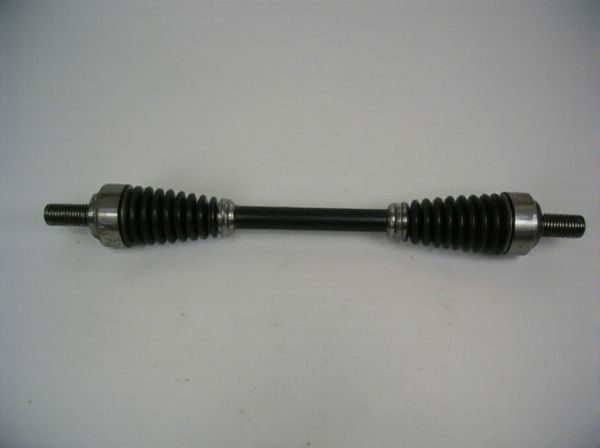
Photo illustration: Tubular Driveshaft vs Bar Driveshaft
A tubular driveshaft offers increased strength-to-weight ratio and better torsional rigidity compared to a bar driveshaft, improving overall vehicle performance and fuel efficiency. Bar driveshafts, typically heavier and less flexible, may suit budget builds but can struggle under high stress and torque conditions. Choosing the right driveshaft enhances your vehicle's reliability and smooth power delivery.
Table of Comparison
| Feature | Tubular Driveshaft | Bar Driveshaft |
|---|---|---|
| Material | Hollow steel or aluminum tube | Solid steel bar |
| Weight | Lightweight, reduces rotational mass | Heavier, increases rotational inertia |
| Strength | High strength-to-weight ratio | Very strong but heavier |
| Performance | Improves acceleration and handling | Less impact on acceleration |
| Durability | Good fatigue resistance | Extremely durable, resistant to impact |
| Cost | Typically higher due to material and manufacturing | Generally lower cost |
| Applications | Sports cars, racing, performance vehicles | Heavy-duty trucks, off-road vehicles |
Introduction to Driveshafts: Tubular vs Bar
Driveshafts transmit torque and rotation to vehicle wheels, with tubular and bar designs offering distinct performance characteristics. Tubular driveshafts are lightweight, high-strength components made from hollow steel or aluminum, reducing rotational mass and improving acceleration. Bar driveshafts consist of solid steel bars, providing durability and simplicity but at the cost of increased weight and rotational inertia compared to tubular alternatives.
Key Functions of Driveshafts in Automotive Applications
Tubular driveshafts offer superior strength-to-weight ratios, reducing rotational mass and improving vehicle responsiveness. Bar driveshafts, typically solid steel bars, provide durability and cost-effectiveness for applications needing less weight reduction. Both types transmit torque from the engine to the differential, ensuring power transfer necessary for vehicle propulsion and stability during acceleration and deceleration.
Structural Differences: Tubular Driveshaft vs Bar Driveshaft
Tubular driveshafts feature a hollow cylindrical structure that offers a high strength-to-weight ratio, enhancing torsional rigidity while reducing overall weight. Bar driveshafts, constructed from solid metal rods, provide increased durability but often at the expense of added mass and less efficient weight distribution. The hollow design of tubular driveshafts improves vibration dampening and fatigue resistance compared to the solid bar driveshaft, making them preferable in high-performance automotive applications.
Material Composition and Manufacturing Processes
Tubular driveshafts are typically made from lightweight materials such as chromoly steel or carbon fiber, enhancing strength-to-weight ratios and reducing rotational mass. Bar driveshafts are generally manufactured from solid steel bars, offering higher torsional rigidity but increased weight due to the solid cross-section. Advanced manufacturing processes for tubular driveshafts include hydroforming and mandrel bending, while bar driveshafts rely on machining and straightening from solid stock.
Weight Comparison: Tubular Driveshafts vs Bar Driveshafts
Tubular driveshafts typically offer a significant weight advantage over bar driveshafts due to their hollow construction, which reduces rotational mass without sacrificing strength. This weight reduction enhances vehicle performance by improving acceleration, fuel efficiency, and handling response. Bar driveshafts, being solid, are generally heavier and less efficient in minimizing inertial forces during high-speed rotation.
Performance and Efficiency Implications
Tubular driveshafts offer superior torsional rigidity and reduced rotational mass compared to bar driveshafts, resulting in enhanced acceleration and responsiveness in high-performance vehicles. Their lightweight design improves fuel efficiency by minimizing drivetrain losses, while maintaining structural integrity under high stress conditions. Bar driveshafts, although typically more affordable, tend to be heavier and less efficient, potentially limiting vehicle performance and increasing energy consumption.
Durability and Longevity Considerations
Tubular driveshafts offer enhanced durability due to their balanced design, minimizing vibrations and stress concentrations that typically cause fatigue failure in bar driveshafts. The hollow structure reduces weight while maintaining strength, leading to less wear on surrounding components and extending overall drivetrain longevity. Bar driveshafts, being solid, are heavier and more susceptible to surface cracks and deformation under high torque, which can shorten their lifespan compared to tubular alternatives.
Cost Analysis: Tubular vs Bar Driveshafts
Tubular driveshafts often command higher initial costs due to their lightweight materials and advanced manufacturing processes, resulting in better performance and durability. Bar driveshafts, typically made from solid steel, are more budget-friendly but can be heavier and less efficient over time. Evaluating the total cost of ownership includes considering maintenance expenses, fuel efficiency gains, and lifespan, where tubular driveshafts tend to offer long-term savings despite higher upfront investments.
Application Suitability: Which Driveshaft for Which Vehicle?
Tubular driveshafts offer superior strength-to-weight ratios, making them ideal for high-performance sports cars and off-road vehicles requiring enhanced torque capacity and reduced rotational mass. Bar driveshafts, typically solid and heavier, suit passenger cars and light-duty trucks where durability and cost-effectiveness outweigh the need for advanced weight reduction. Selecting the appropriate driveshaft depends on vehicle application, with tubular designs favored for racing and demanding environments, while bar driveshafts perform reliably in everyday commuting and moderate-load conditions.
Conclusion: Choosing the Right Driveshaft for Your Needs
Tubular driveshafts offer superior strength-to-weight ratios and better resistance to torsional stress, making them ideal for high-performance and racing applications. Bar driveshafts, typically bulkier and heavier, provide cost-effective durability suitable for standard vehicles and heavy-duty use. Selecting the right driveshaft depends on balancing performance requirements, budget constraints, and specific vehicle demands to ensure optimal drivetrain efficiency.
 caratoz.com
caratoz.com